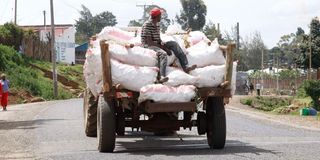Dicey outlook for Kenya as maize surpluses dwindle around the globe

A tractor ferries harvested maize along the Elburgon-Molo highway in Nakuru County last month.
Kenya is only self-sufficient in its staple food product, white maize, when there has been a good harvest and adequate rainfall. Formal and informal imports from Uganda and Tanzania have often plugged the gap as traditionally they are net surplus producers.
This year the picture is particularly challenging because of the prolonged drought and several deficient rain seasons. Kenya’s traditional maize surplus area of Trans-Nzoia and North Rift had a crop that was well below average.
The government is projecting that the country will need to import 900,000 metric tonnes (10 million bags) between January and August 2023. That is a huge logistical exercise of over one million bags being landed and transported each month, a big challenge in itself.
A little will come from Uganda, which has a small surplus. Uganda is also a major supplier to South Sudan and food aid organisations fiercely compete for its supplies. If we are lucky, we could get 500,000 bags of the 10 million that we need, but it will not be cheap.
None, or very little, will come from our other traditional supplier and neighbour — Tanzania. The country has a 15 per cent shortfall and needs to import maize amid strict export restrictions. This is a good reflection of the severity of the drought.
Landlocked Zambia
One country that has a surplus is Zambia, but there are two challenges there. One is that there is a lot of demand from its neighbours such as Zimbabwe and Malawi, which are easier to transport to. The second is that the logistics of getting maize from landlocked Zambia to Kenya via sea or land are complex and daunting.
The most logical one, land, means crossing Tanzania along with its heavy-handed bureaucracy and existing restrictions on maize movement, especially by truckers.
This time around South Africa is a non-potential supplier because of its complex bureaucracy separating GMO and non-GMO, availability and the logisitics of getting non-GMO white maize from locations like Durban to Mombasa.
Again, a good example of a country playing safe and keeping what it has to itself.
It must be remembered that white maize is a thin market worldwide. This is in addition to the general shortages in the white maize market as a whole. It is also complicated by the non-GMO and GMO factor. The former is an exceedingly thin market at present and there is a limited supply of GMO white maize worldwide within that thin market framework.
Chances are that Kenya would not get enough GMO maize even if it agreed to that, for the simple reason that there is not enough in the market. This makes the debate about whether to exclude GMO maize rather academic, as there is just not enough around anyway.
If African consumers do not have enough white maize, what other options does Kenya have?
In truth, few or none. One fallback supplier of white maize in the past has been Mexico. It is a totally different story that shows there are little or no surpluses especially if a country wants to keep enough for domestic consumption.
Mexico has in place a 50 per cent export tax on white maize, which is likely to last for the foreseeable future. This provides a huge disincentive to importers because your landed cost, even duty-free, would be well above domestic prices.
It must be emphasised that Kenya is in a short-term fix and needs maize in the next month or so onwards. Crop projections for later in the year are better but the problem is now and the next few months.
The US is largely a GM producer, so that becomes a non-option. Secondly, the US, like South Africa, is keen to ensure its domestic market has enough.
All in all, there are no ready, reasonably priced white non-GMO surpluses around the world. There are little bits and pieces like some from Uganda, but not enough to fill what is a gaping hole. Indeed, even if the government eased its fixation about white GMO, it is still unlikely there would be enough to fill the supply-and-demand gap.
The inevitable scenario is one of a very tight supply chain whether we like it or not, which will put an upward pressure on prices. Bearing in mind that the government is dependent on IMF and World Bank support at present, it is unlikely to go down the populist road of subsidies.
The government and indeed the country is caught between a rock and a hard place. It literally has few options but to encourage importers and millers to scavenge what they can get from wherever. Are there any options out of the proverbial box? One possibly.
Yellow maize
If Ukraine continues to manage to ship its huge yellow maize surpluses, then Kenya could tap into that for animal feed, thus releasing white maize for humans.
This does require an assertive government policy with a yellow maize duty-free window and an educational policy about the benefits of importing yellow maize for animal feeds.
Kenyans will have to accept the reality of high and hardening prices of white maize for the foreseeable future and hope that government can have a pragmatic approach to imported yellow maize, which in turn will alleviate the overall supply dilemma.
Last, but not least, it should have a more proactive policy to the way farmers millers and distributors manage and these small domestic surpluses. The name of the game is to get what little there is to as many as possible in a facilitative manner.
Robert Shaw is a public policy and economic analyst:[email protected]





